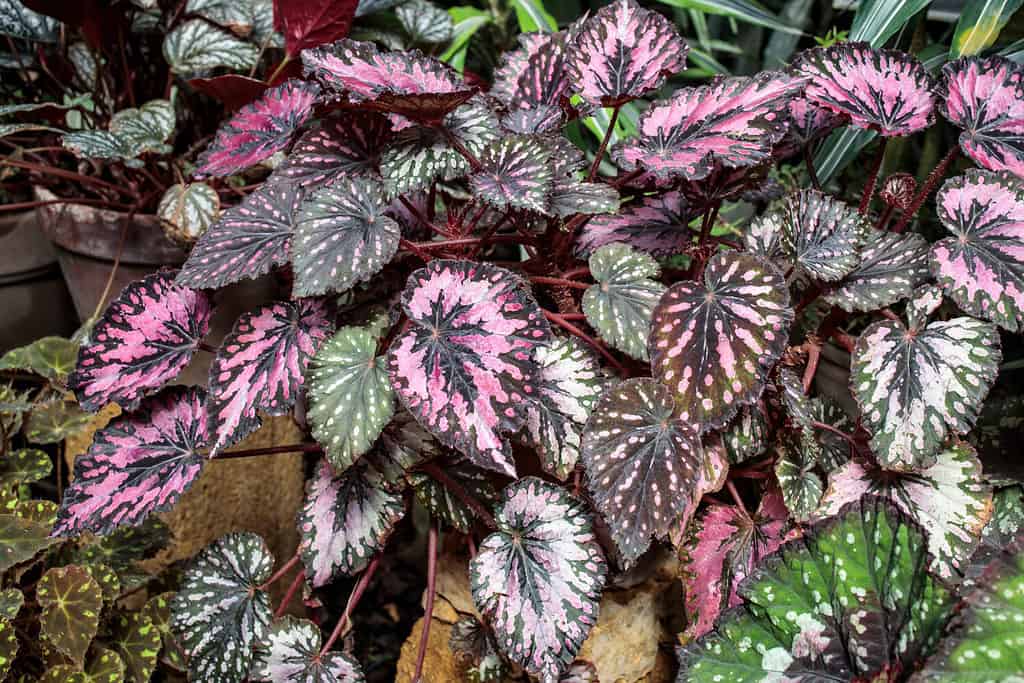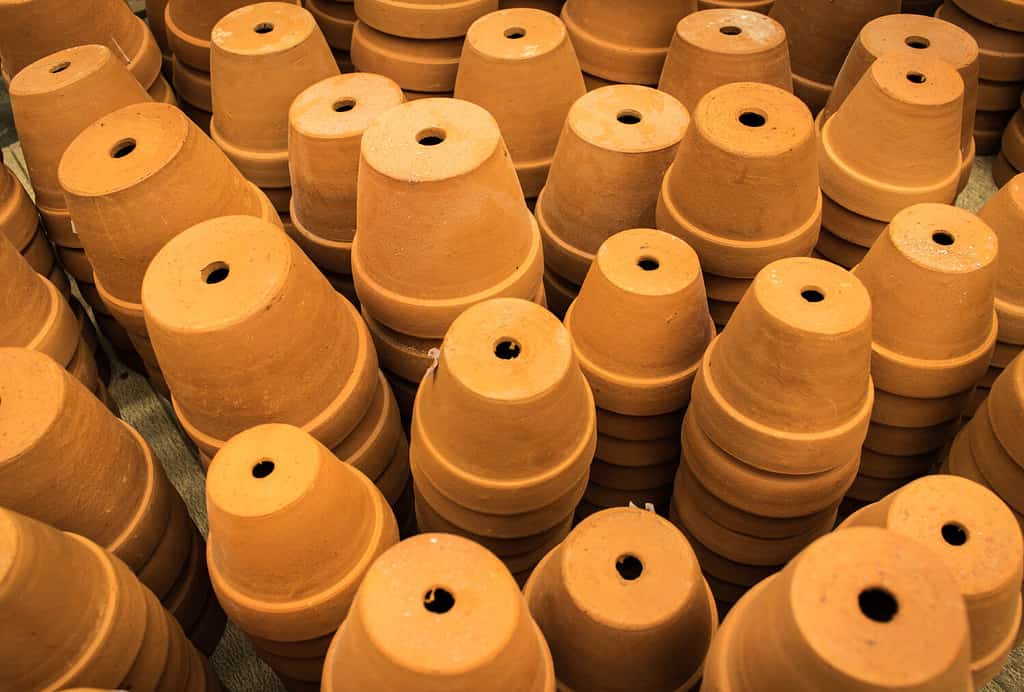Hardy and easy to care for yet an impressively colorful plant, the rex begonia is also known as the king begonia or the painted leaf begonia. Over 500 unique cultivars exist! Its vibrant foliage is perfect for adding color to your home or garden. Below, we’ll take an in-depth look at how to grow them indoors, what you’ll need, and what to expect from them, even if you’re a total beginner to raising houseplants.
Growing Rex Begonias Indoors: What You Should Know First

The rex begonia is often known as the painted-leaf begonia for the bright pink splotches across its leaves.
©Elena Rostunova/Shutterstock.com
Before we understand what you’ll need and the ideal conditions for the rex begonia, we’ll briefly discuss its background, taxonomy, and history as a houseplant. Additionally, we’ll touch on some interesting facts about the plant you should know before bringing it into your home or garden.
Native to northeast India and parts of southeast China, the rex begonia was initially discovered in the Indian state of Assam. However, starting in the 1850s, it was introduced to areas well outside its range. This includes Bangladesh as well as the islands of Cuba and Hispaniola. It quickly became a popular houseplant for its hardy nature, handsome ornamental leaves, and pale pink flowers.
As a perennial species, the rex begonia can live for over a decade if given proper care and raised in suitable conditions. Its large leaves can take on a wide range of shapes and colors. The overall size of its leaves also varies, ranging from just 8 cm to over 30 cm in length.
Despite being native to more tropical regions, this handsome plant thrives well in temperate climates. A comfortable room temperature is perfect for the rex begonia, and does well in moderate to bright indirect sunlight.
The rex begonia is part of the Begoniaceae family. This is a large group of flowering plants with over 2,000 species comprising two distinct genera. Nearly all these species, including the rex begonia, fall under the Begonia genus. The only other genus in the family, Hillebrandia, is native to the Hawaiian islands. It contains just one species: the aka’aka’awa, taxonomically known as the Hillebrandia sandwicensis.
What You’ll Need: Supplies

You must ensure the planter you select for your rex begonias has proper drainage holes.
©Zulashai/Shutterstock.com
Are you ready to purchase a Rex begonia plant to raise and cultivate at home? If so, here are a few supplies you might need to ensure it thrives.
- A large, wide planter with proper drainage. The planter doesn’t necessarily have to be very deep. However, it should be pretty broad to allow the plant to spread its roots. Remember that rex begonias can grow around 12 to 24 inches in height. Their leaves can also have a wide spread. At least one drainage hole is necessary, as you’ll need to let the top inch or so of soil dry out in between waterings.
- A watering can–avoid a mister. Watering directly rather than misting is best to prevent mildew.
- Peat-based potting soil mixture. A pH level of 5.5 to 6.4 is best. Many types of potting soil available from your local hardware or garden shop are pre-packaged and ready to be used straight from the bag. Peat is a mixture of decaying vegetation and/or other organic matter.
- A plant/soil hygrometer. This can help you more accurately measure the humidity of the soil and ensure it is within an ideal range. These are also often available at garden and hardware shops and have a long stem that can go directly into the planter’s soil.
- A 65F to 75F degree room in which to house the plant. If you’re comfortable, your rex begonia will likely find the conditions tolerable, too.
- Adequate indirect sunlight. Rex begonias aren’t very picky about sunlight. Generally, moderate to bright indirect sunlight is best. Too much sun can dry out the plant’s beautiful ornamental leaves. They also fare well under fluorescent lighting, making them great indoor plants.
- Fertilizer. A foliage feed with a ratio of 15-15-15 or 7-9-5 (of nitrogen, phosphorus, and potassium) is best for the rex begonia. Nitrogen is your plant’s most important nutrient; a once-per-month feeding is ideal.
- A round tray and some gravel or pebbles. Placing the planter on top of some small stones can help keep the humidity above 50%. 50%+ humidity is ideal for your rex begonia.
- An indoor thermometer, ideally one designed for plants. Some indoor thermometers are three-in-one: they can track humidity, temperature, and even the soil’s pH level. This can eliminate the need for a separate hygrometer. Alternatively, you can place a separate indoor thermometer next to your planter.
Ideal Conditions For Indoor Rex Begonias

Rex begonias are available in a wide range of colors.
©Lienda Yunita Apponno/Shutterstock.com
Once you have your supplies, you’ll want to ensure the conditions and place you’ve selected for your rex begonia are conducive to its growth and overall health. Let’s go over each condition in more depth below.
- Humidity: This should be at least 50%. Although rex begonias are very hardy and can tolerate dry conditions, they are native to tropical climates and prefer high humidity. However, remember to water them directly and avoid misting, as this can quickly cause mildew and discolor or even kill off your plant’s leaves.
- Temperature: 65F to 75F is ideal. Remember, as we touched on earlier, if you feel comfortable, your rex begonia is likely enjoying the conditions, too.
- Space: Since rex begonias can grow to around two feet tall and also be quite wide, make sure you have enough room for your planter, as well as additional room for the plant’s many large, wide leaves.
- Water: Water your rex begonia around once to twice per week. You’ll want to allow the top inch or so of soil to dry out completely in between waterings. This will prevent overwatering and, again, mildew from forming.
- Sunlight: Placing your rex begonia near a window with moderate to bright indirect sunlight is best. However, they also do fairly well under fluorescent lighting, so you have many options for placement.
- Feeding: As mentioned above, you only need to feed your rex begonia with your 15-15-15 (or 7-9-5) fertilizer once a month. Ensure you also get rid of dead growth or leaves to prevent pests, disease, and mildew from forming.
Maintaining Rex Begonias in Your Home
Once your rex begonia is settled into its planter and the spot you plan on cultivating in your home, it needs little regular maintenance. As an ornamental plant with a rich history, it is extremely popular for its hardy, low-maintenance nature. We’ve already addressed much of the basics regarding maintenance. We’ve all the needed maintenance in the ideal conditions and supplies sections.
Beyond this, stick to a weekly watering schedule. You can stick a finger into the top inch or two of soil every few days to check on how quickly the water is draining and absorbing. This will allow you to fine-tune how much water your plant needs per week. Remember, the top inch of soil should dry out completely in between waterings!
Additionally, check your thermostat and hygrometer often. Daily monitoring for any changes is best. If the humidity level is too low, add water. If it’s too high, water less frequently. Additionally, adjust the thermostat accordingly if the temperature is too high or too low. Alternatively, if you’ve purchased a three-in-one gauge, you can also monitoryou’veoil’s pH level at a glance.
Finally, remember to fertilizsoil’s per month and eliminate any dead leaves or growth to keep away pests and prevent mildew and disease.
At-a-Glance Recap: Conditions and Facts
| Scientific Name | Begonia rex |
| Common Name | Rex begonia, painted leaf begonia, king begonia |
| Unique Cultivars | 500+ |
| Native Habitat | Once weekly, allow top inch of soil to dry out between waterings |
| Temperature | 65F to 75F |
| Humidity | Above 50% |
| Watering | Once weekly, allow the top inch of soil to dry out between waterings |
| Fertilizer | 15-15-15 or 7-9-5 once per month |
The photo featured at the top of this post is © Elena Rostunova/Shutterstock.com
Thank you for reading! Have some feedback for us? Contact the AZ Animals editorial team.







